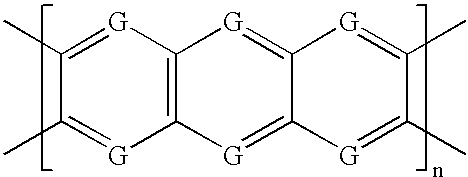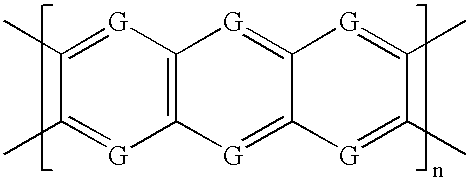Electrochemical capacitors having electrodes with diverse redox potentials
a technology of redox potential and electrodes, applied in the field of electrochemical capacitors, can solve the problems of limited cycle life, high cost, and limited power performance of readily available ec products, and achieve the effect of increasing the performance of electrochemical capacitors
- Summary
- Abstract
- Description
- Claims
- Application Information
AI Technical Summary
Benefits of technology
Problems solved by technology
Method used
Image
Examples
example 1
A weighed sample of fibrils was slurried with nitric acid of the appropriate strength in a bound bottom multi-neck indented reactor flask equipped with an overhead stirrer and a water condenser. With constant stirring, the temperature was adjusted and the reaction carried out for the specified time. Brown fumes were liberated shortly after the temperature exceeded 70.degree. C., regardless of acid strength. After the reaction, the slurry was poured onto cracked ice and diluted with deionized water. The slurry was filtered and excess acid removed by washing in a Soxhlet extractor, replacing the reservoir with fresh deionized water every several hours, until a slurried sample gave no change in pH from deionized water. The fibrils were dried at 1000.degree. C. at 5" vacuum overnight.
1.3 g of the dried fibrils were slurried in fresh deionized water and filtered on a 7 cm diameter filter paper to form a thin sheet of the oxidized fibrils.
The fibril sheet material, labeled 170-42, was soa...
PUM
| Property | Measurement | Unit |
|---|---|---|
| surface area | aaaaa | aaaaa |
| thickness | aaaaa | aaaaa |
| equivalent series resistance | aaaaa | aaaaa |
Abstract
Description
Claims
Application Information
 Login to View More
Login to View More - R&D
- Intellectual Property
- Life Sciences
- Materials
- Tech Scout
- Unparalleled Data Quality
- Higher Quality Content
- 60% Fewer Hallucinations
Browse by: Latest US Patents, China's latest patents, Technical Efficacy Thesaurus, Application Domain, Technology Topic, Popular Technical Reports.
© 2025 PatSnap. All rights reserved.Legal|Privacy policy|Modern Slavery Act Transparency Statement|Sitemap|About US| Contact US: help@patsnap.com



